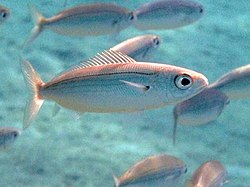Boops boops
Species of seabream From Wikipedia, the free encyclopedia
Boops boops (/ˈboʊ.ɒps ˈboʊ.ɒps/ BOH-ops; from Ancient Greek βόωψ, lit. 'ox-eyed'), commonly called the bogue, is a species of seabream native to the eastern Atlantic.[2]
| Boops boops | |
|---|---|
 | |
| School of Boops boops off the coast of Greece | |
| Scientific classification | |
| Domain: | Eukaryota |
| Kingdom: | Animalia |
| Phylum: | Chordata |
| Class: | Actinopterygii |
| Order: | Acanthuriformes |
| Family: | Sparidae |
| Genus: | Boops |
| Species: | B. boops |
| Binomial name | |
| Boops boops | |
| Synonyms | |
| |
Taxonomy
In the fourth century BCE, Boops boops was documented by Aristotle as box (Ancient Greek: βῶξ) in his Historia Animalium.[3] In the early third century CE, Athenaeus, in his Deipnosophistae, also called the fish box and suggested that the name came from the sound that the fish makes (Ancient Greek: βοή, lit. 'roar'). The name boops (Ancient Greek: βόωψ, lit. 'ox-eyed') is mentioned due to the fish's large eyes.[4][5] The first scientific description comes from Carl Linnaeus in the tenth edition of Systema Naturae as Sparus boops. It was later reclassified under the genus Boops.[6]
Distribution and habitat
The species is found off the coasts of Europe, Africa, the Azores and the Canary Islands, from Norway to Angola, and in the Mediterranean and Black Seas. It avoids brackish waters such as the Baltic Sea. A demersal and semi-pelagic feeder, it can generally be found at a depth of 100 m (330 ft), and infrequently down to 350 m (1,150 ft).[7]
Ecology
It consumes seaweed, crustaceans, and some plankton, in schools that rise to the surface at night. Individuals can reach 36 cm (14 in), but average 20 cm (7.9 in).
Sex determination in the bogue is unclear. It has variously been described as a rudimentary intersex organism, with a few intersex individuals, or a protogynous intersex, with individuals starting out life as females, and some becoming male later on.[7]
Human use


The species is commercially fished, with 37,830 tonnes taken in 2008.[2] European Commission standards include three size categories for Boops boops, from size 3, which is between 32 and 70 fish per kilogram, to size 1, which is no more than 5 fish per kilogram.[8]
When cleaned and pan fried, broiled or baked fresh, they are good tasting, but when stored their gut flora soon spread unpleasant flavors to their flesh.
Their shelf life is limited, as when stored at freezing (0 °C) for a week, or slightly above freezing for 2 to 4 days, the taste after cooking becomes of "unacceptable quality".[9] Much of the catch is used for fishmeal or tuna fishing bait.[citation needed] Boops boops has been used as an indicator of microplastic pollution in the Mediterranean sea.[10][11]
Parasites
The bogue is host to a wide variety of parasites, ranging from metazoans such as monogenean flatworms (e.g. Microcotyle isyebi[12] and Cyclocotyla bellones) acanthocephalan spiny-headed worms, nematode roundworms, isopod and copepod crustaceans and myxozoan cnidarians to the unicellular dinoflagellate Ichthyodinium chabelardi, a parasite lethal to eggs developing in ovaries. At least 67 metazoan parasite species have been reported from the species.[13] In the aftermath of the 2002 Prestige oil spill, the community of parasitic species inhabiting bogue caught off the coast of Spain was noticeably altered.[14]
References
External links
Wikiwand - on
Seamless Wikipedia browsing. On steroids.

